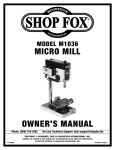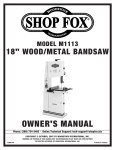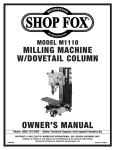Download Woodstock W1675 User's Manual
Transcript
MODEL W1675 13" Portable Planer INSTRUCTION MANUAL Phone: 1-360-734-3482 • On-Line Technical Support: [email protected] COPYRIGHT © NOVEMBER, 2002 BY WOODSTOCK INTERNATIONAL, INC. WARNING: NO PORTION OF THIS MANUAL MAY BE REPRODUCED IN ANY SHAPE OR FORM WITHOUT THE WRITTEN APPROVAL OF WOODSTOCK INTERNATIONAL, INC. Printed in Taiwan WARNING Some dust created by power sanding, sawing, grinding, drilling, and other construction activities contains chemicals known to the State of California to cause cancer, birth defects or other reproductive harm. Some examples of these chemicals are: • Lead from lead-based paints. • Crystalline silica from bricks, cement, and other masonry products. • Arsenic and chromium from chemically treated lumber. Your risk from these exposures varies, depending on how often you do this type of work. To reduce your exposure to these chemicals: work in a well ventilated area, and work with approved safety equipment, such as those dust masks that are specially designed to filter out microscopic particles. PAGE INTRODUCTION ................................................................................2 SAFETY FIRST..................................................................................4 Standard Safety Instructions ....................................................................4-5 SAFETY About Your New Planer ..............................................................................2 Woodstock Service and Support....................................................................2 Warranty and Returns ................................................................................3 Specifications ..........................................................................................3 INTRODUCTION TABLE OF CONTENTS ADDITIONAL SAFETY INSTRUCTIONS FOR PLANERS ....................................6 Avoiding Potential Injuries ........................................................................7 ASSEMBLY ......................................................................................9 ASSEMBLY Unpacking ..............................................................................................9 Box Contents ..........................................................................................9 Shop Preparation ......................................................................................9 Cleaning Machine ....................................................................................10 Beginning ..............................................................................................10 Mounting ..............................................................................................11 Handwheel ............................................................................................12 Dust Port ..............................................................................................12 ADJUSTMENTS ELECTRICAL ....................................................................................8 110V Operation ........................................................................................8 Extension Cords........................................................................................8 Grounding ..............................................................................................8 ADJUSTMENTS ..............................................................................13 OPERATIONS..................................................................................18 Starting the Planer ..................................................................................18 Basic Operations ....................................................................................19 Troubleshooting ......................................................................................21 Lubrication ............................................................................................22 General ................................................................................................22 Brush Replacement ..................................................................................22 Table and Base ......................................................................................22 CLOSURE ......................................................................................23 MAINTENANCE MAINTENANCE................................................................................22 OPERATIONS Controls ................................................................................................13 Turning / Changing Knives ........................................................................14 Extension Tables ....................................................................................17 Parts Breakdown and Parts List ..............................................................24-27 Your Notes ............................................................................................28 -1 - PARTS USE THE QUICK GUIDE PAGE LABELS TO SEARCH OUT INFORMATION FAST! INTRODUCTION INTRODUCTION About Your New Planer Your new SHOP FOX® Planer has been specially designed to provide many years of trouble-free service. Close attention to detail, ruggedly built parts and a rigid quality control program assure safe and reliable operation. The Model W1675 is a great portable planer that packs an impressive punch for its size. Unlike most planers of similar size, the Model W1675 takes stock to a maximum width of 13" which further expands your planing capabilities. The Model W1675 has many features and gives excellent planing results and years of service. Woodstock International, Inc. is committed to customer satisfaction in providing this manual. It is our intent to make sure all the information necessary for safety, ease of assembly, practical use and durability of this product be included. If you should have any comments regarding this manual, please feel free to contact us at: Woodstock International, Inc. Attn: Technical Department P.O. Box 2309 Bellingham, WA 98227 Woodstock Service and Support We stand behind our machines! In the event that a defect is found, parts are missing or questions arise about your machine, please contact Woodstock International Service and Support at 1-360-734-3482 or send e-mail to: [email protected]. Our knowledgeable staff will help you troubleshoot problems, send out parts or arrange warranty returns. -2- Woodstock International, Inc. warrants all SHOP FOX® machinery to be free of defects from workmanship and materials for a period of 2 years from the date of original purchase by the original owner. This warranty does not apply to defects due directly or indirectly to misuse, abuse, negligence or accidents, lack of maintenance, or to repairs or alterations made or specifically authorized by anyone other than Woodstock International, Inc. Woodstock International, Inc. will repair or replace, at its expense and at its option, the SHOP FOX® machine or machine part which in normal use has proven to be defective, provided that the original owner returns the product prepaid to the SHOP FOX® factory service center or authorized repair facility designated by our Bellingham, WA office, with proof of their purchase of the product within 2 years, and provides Woodstock International, Inc. reasonable opportunity to verify the alleged defect through inspection. If it is determined there is no defect, or that the defect resulted from causes not within the scope of Woodstock International Inc.'s warranty, then the original owner must bear the cost of storing and returning the product. This is Woodstock International, Inc.'s sole written warranty and any and all warranties that may be implied by law, including any merchantability or fitness, for any particular purpose, are hereby limited to the duration of this written warranty. We do not warrant that SHOP FOX® machinery complies with the provisions of any law or acts. In no event shall Woodstock International, Inc.'s liability under this warranty exceed the purchase price paid for the product, and any legal actions brought against Woodstock International, Inc. shall be tried in the State of Washington, County of Whatcom. We shall in no event be liable for death, injuries to persons or property or for incidental, contingent, special or consequential damages arising from the use of our products. Every effort has been made to ensure that all SHOP FOX® machinery meets high quality and durability standards. We reserve the right to change specifications at any time because of our commitment to continuously improve the quality of our products. Specifications Motor Size ..................................................................2 HP, 110V, Universal Amperage Draw ....................................................................................15 Maximum Width of Cut ..........................................................................13" Maximum Depth of Cut at 13" Width ........................................................1⁄16" Maximum Depth of Cut at 5" Width ..........................................................1⁄8" Maximum Cutting Height..........................................................................6" Minimum Stock Length ............................................................................6" Cutterhead ..............................................................2 Knife, 129⁄32" Diameter Cutterhead Speed ........................................................................9000 RPM Cuts Per Minute ..............................................................................18,000 Feed Rate ....................................................................................26 FPM Machine Weight ..............................................................................93 lbs -3- INTRODUCTION Warranty and Returns SAFETY SAFETY FIRST! READ MANUAL BEFORE OPERATING MACHINE. FAILURE TO FOLLOW INSTRUCTIONS BELOW WILL RESULT IN PERSONAL INJURY. Indicates an imminently hazardous situation which, if not avoided, WILL result in death or serious injury. Indicates a potentially hazardous situation which, if not avoided, COULD result in death or serious injury. Indicates a potentially hazardous situation which, if not avoided, MAY result in minor or moderate injury and/or damage to the machinery. NOTICE This symbol is used to alert the user to useful information about proper operation of the equipment. Standard Safety Instructions 1. Thoroughly read the instruction manual before operating your machine. Learn the applications, limitations and potential hazards of this machine. Keep manual in a safe, convenient place for future reference. 2. Keep work area clean and well lighted. Clutter and inadequate lighting invite potential hazards. 3. Ground all tools. If a machine is equipped with a three-prong plug, it must be plugged into a threehole grounded electrical outlet or grounded extension cord. If using an adapter to aid in accommodating a two-hole receptacle, ground using a screw to a known ground. 4. Wear eye protection at all times. Use safety glasses with side shields or safety goggles that meet the national safety standards, while operating this machine. 5. Avoid dangerous environments. Do not operate this machine in wet or open flame environments. Airborne dust particles could cause an explosion and severe fire hazard. 6. Ensure all guards are securely in place and in working condition. 7. Make sure switch is in the “OFF” position before connecting power to machine. 8. Keep work area clean, free of clutter, grease, etc. 9. Keep children and visitors away. Visitors should be kept a safe distance away while operating unit. 10. Childproof workshop with padlocks, master switches or by removing starter keys. 11. Disconnect machine when cleaning, adjusting or servicing. -4- 12. Do not force tool. The machine will do a safer and better job at the rate for which it was designed. 13. Use correct tool. Do not force machine or attachment to do a job for which it was not designed. 14. Wear proper apparel. Do not wear loose clothing, neck ties, gloves, jewelry, keep long hair tied up, etc. 16.Use proper extension cord. Examine the 16. extension cord to ensure it is in good condition. Use TABLE 1 to determine the correct length and gauge of extension cord needed for your particular needs. The amp rating of the motor can be found on its nameplate. If the motor is dual voltage, be sure to use the amp rating for the voltage you will be using. If you use an extension cord with an undersized gauge or one that is too long, excessive heat will be generated within the circuit increasing the chance of a fire or damage to the circuit. Always use an extension cord that uses a ground pin and connected ground wire. Immediately replace a damaged extension cord. Extension Cord Requirements TABLE 1 Amp Rating 0-6 7-10 11-12 13-16 17-20 21-30 Length 25ft #18 #18 #16 #14 #12 #10 and Gauge 50ft 100ft #16 #16 #16 #14 #16 #14 #12 #12 #12 #10 #10 No 17. Keep proper footing and balance at all times. 18. Do not leave machine unattended. Wait until it comes to a complete stop before leaving the area. 19. Perform machine maintenance and care. Follow lubrication and accessory attachment instructions in the manual. 20. Keep machine away from open flame. Operating machines near pilot lights and/or open flames creates a high risk if dust is dispersed in the area. Dust particles and an ignition source may cause an explosion. Do not operate the machine in high-risk areas, including but not limited to, those mentioned above. Always wear safety glasses or goggles when operating equipment. Operating this equipment creates the potential for flying debris that can cause eye injury. Everyday glasses or reading glasses only have impact resistant lenses, they are not safety glasses. Be certain the safety glasses you wear meet the appropriate standards of the American National Standards Institute (ANSI). 21. If at any time you are experiencing difficulties performing the intended operation, stop using the machine! Then contact our service department or ask a qualified expert how the operation should be performed. 22. Habits—good and bad—are hard to break. Develop good habits in your shop and safety will become second-nature to you. -5- SAFETY 15. Remove adjusting keys and wrenches. Before turning the machine on, make it a habit to check that all adjusting keys and wrenches have been removed. SAFETY ADDITIONAL SAFETY INSTRUCTIONS FOR PLANERS MODEL W1675 13" Portable Planer INSTRUCTION MANUAL Phone: 1-360-734-3482 • On-Line Technical Support: [email protected] COPYRIGHT © July, 2002 BY WOODSTOCK INTERNATIONAL, INC. WARNING: NO PORTION OF THIS MANUAL MAY BE REPRODUCED IN ANY SHAPE OR FORM WITHOUT THE WRITTEN APPROVAL OF WOODSTOCK INTERNATIONAL, INC. Printed in Taiwan Read and understand this entire instruction manual before using this machine. Serious personal injury may occur if safety and operational information is not understood and followed. Do not risk your safety by not reading! Use this and other machinery with caution and respect and always consider safety first, as it applies to your individual working conditions. Remember, no list of safety guidelines can be complete and every shop environment is different. Failure to follow guidelines can result in serious personal injury, damage to equipment and/or poor work results. 1. ALWAYS make sure the planer is on firm ground and is stable before operating. Immediately fix or shim the planer if it rocks or wobbles. 2. ALWAYS inspect the workpiece before running it through the planer. Do not plane stock with loose knots, nails, staples, dirt or other foreign objects. Always reject the wood or correct the problems with the wood before planing. 3. ALWAYS make sure that all components of the planer are adjusted to their proper specifications before planing stock. 4. ALWAYS use the help of another person or some type of support fixture when planing long stock. 5. ALWAYS stand clear of the workpiece when you are feeding it into the planer; otherwise, the workpiece could possibly kick back and hit you or bystanders. 6. ALWAYS operate the planer with sharp and undamaged knives to achieve safe operation and quality planing results. 7. ALWAYS plane wood, never plane any material other than wood like particle board, MDF, or other wood products that are not natural wood grain. This planer is designed for wood only. 8. ALWAYS plane with multiple light cuts rather than excessively deep cuts. 9. ALWAYS wear hearing and eye protection and a dust mask when operating the planer. 10. NEVER attempt to free a stalled workpiece while the planer is powered on and plugged in. 11. ABSOLUTELY NEVER reach inside the planer or open the top cover while the planer is powered on and/or plugged in. 12. NEVER plane wood that is less than 6" long or less than 1⁄4" thick. -6- AVOIDING POTENTIAL INJURIES SAFETY Figure 1. DO NOT place hands inside planer when operating. Figure 2. Feed wood by hand only until planer feed roller begins to pull wood inside planer. Figure 3. DO NOT stand directly behind workpiece line of travel. Figure 4. Stand out of the way of the workpiece line of travel. -7- SAFETY ELECTRICAL 110V Operation Grounding The SHOP FOX® W1675 is prewired for 110 volts. The 2 HP motor draws approximately 15 amps. Choose an outlet with 15 amp circuit breaker or fuse protection. Remember circuits being used by other machines at the same time add to the total electrical load being applied by this machine. Add up the amperage load ratings of all machines on the circuit. If this total amperage load exceeds the amperage rating of the circuit breaker or fuse, use a different circuit with a higher amperage rating. Any electrical outlet and circuit that you plug your machine into must be grounded. Serious injury and/or fire may occur if this warning is ignored! Ground this machine! The electrical cord supplied with the Model W1675 comes with a grounding pin. Do not remove the pin if your outlet does not accept a ground pin, see Figure 5. Have the outlet box replaced by a qualified electrician or have an appropriate adapter installed. DO NOT modify an existing low-amperage circuit by only replacing the circuit breaker with a breaker rated for a higher amperage. The breaker and the complete circuit must be replaced by a qualified electrician. NOTICE Make sure when using an adapter, the adapter is grounded. Extension Cords Remember, an adapter with a grounding wire does not guarantee the machine will be grounded. A ground source must always be verified in the electrical circuit within the wall or conduit. Using extension cords with an undersized gauge or one that is too long, generates heat in the cord that may cause fire or circuit damage. If you must use an extension cord, use the guidelines below and TABLE 2 to determine the correct cord length and gauge. The amp rating of the motor is 15 amps and can be found on its nameplate. •Use •Use •Use •Use a cord rated for Hard Service (Grade S) a cord that is 100 feet or less only a cord with a ground wire and pin only undamaged cords Extension Cord Requirements TABLE 2 Amp Rating 0-6 7-10 11-12 13-16 17-20 21-30 Length 25ft #18 #18 #16 #14 #12 #10 and Gauge 50ft 100ft #16 #16 #16 #14 #16 #14 #12 #12 #12 #10 #10 No Figure 5. Never remove grounding pin. -8- ASSEMBLY Unpacking Shop Preparation Get assistance before starting assembly. The Model W1675 Planer is a heavy load at 93 pounds. The planer is carefully packed. However, if it is damaged or is missing any parts, please contact Woodstock International Service and Support at 1-360-734-3482 or send e-mail to: [email protected]. Box Contents • Planer Location: Make sure that where ever you operate the planer, you face the planer toward an area where if a work piece should be projected, bystanders will not be struck with the workpiece. Take all necessary safety precautions. • Working Clearances: Consider your existing and anticipated needs, size of material to be processed through each machine, and space for auxiliary stands, work tables or other machinery when establishing a location for your planer. • Lighting: Make sure the lighting is bright enough to eliminate shadows and prevent eye strain. • Outlets: Electrical circuits must be dedicated and/or large enough to handle the amperage requirements of the machinery. Electrical outlets should be located near each machine so power or extension cords are clear of high-traffic areas. Observe local electrical codes for proper installation of new lighting, outlets or circuits and read and understand this manual. Layout and inventory the parts shipped with your Planer. See Figure 6. This will help with machine assembly. Item Qty. Planer Unit Handwheel Magnets T-Handle Allen® Wrench Allen® Screw Flat/Lock Washer Dust Port Phillips® Screws 1 1 2 1 1 1 1 3 Planer Dust Port Phillips® Screw T-Handle Allen Wrench Flat/Lock Washers Allen® Screw Handwheel Magnets Figure 6. Planer components removed from the box and laid out for identification. -9- ASSEMBLY Always make sure that all entrances to your shop are locked or that machines are equipped with safety lock-out devices to protect curious children or visitors from serious injury. Never allow unsupervised people in your shop who have not been fully trained! ASSEMBLY Cleaning Machine Beginning The Model W1675 table and other unpainted parts are coated with a waxy grease for corrosion protection. For the best machine performance, clean all moving parts and coated surfaces. Remove this grease with a solvent cleaner or a citrus-based degreaser. Do not use chlorine-based solvents—if you splash these solvents onto a painted surface, you will ruin painted and plastic finishes. Although the main components of the SHOP FOX® W1675 are assembled at the factory, some assembly is required. The following series of instructions are the recommended sequence for final assembly. All tools required for assembly have been included with the planer except standard-head and Phillips®-head screwdrivers. Before cleaning the machine, read and understand the following Warnings and Caution: Keep your machine unplugged during any assembly, adjustments, or maintenance procedures. Ignoring this warning may result in serious personal injury! Never use flammables such as gas or other petroleum-based solvents to clean your machine. These products have low flash points and present the risk of explosion and severe personal injury! Never smoke while using cleaning solvents. Smoking may cause explosion or risk of fire when exposed to these products! Most solvents used to clean machinery are toxic when inhaled or ingested. When using these products, work in a well ventilated area and keep away from any potential ignition sources (pilot lights). Always dispose of any waste rags in a sealed container to make sure they do not cause fire or environmental hazards. -10- Mounting For proper results and safe use, the Model W1675 must be mounted to a sturdy workbench or a stand like the SHOP FOX® Tool Stand shown in Figure 7. Mounting hardware is not included. To mount the planer do these steps: Determine the length of mounting bolts you will need by adding the thickness of your mounting surface and the base of the planer. 2. With the help of an assistant set the planer in the desired position on the mounting Figure 7. SHOP FOX® Tool Stand. Get assistance before starting assembly. The Model W1675 Planer is a heavy load at 93 pounds. 3. Figure 8. Planer in mounted position. Planer Base surface. See Figure 8. Use a pencil to mark the positions of the mounting holes from the base of the planer. 4. Drill a 1⁄2" hole into your mounting surface in each of these positions. 5. Secure the planer with the mounting hardware. Figure 9 shows the proper order of the mounting hardware placement. 6. Insert a 1⁄2" diameter bolt, two flat washers (1 for top, 1 for bottom), and thread on a lock washer (for behind nut), and a hex nut to secure the planer at each corner. NOTICE DO NOT over tighten the bolts as damage to the base will result. Mounting Surface Figure 9. Hardware mounting assembly. -11- ASSEMBLY 1. Handwheel Handle Roll Pin ASSEMBLY To mount the handwheel to the planer do these steps: 1. If not already done, insert the roll pin into the shaft protruding from the front of the planer. See Figure 10. 2. Slide the handwheel onto the shaft and align the handwheel with the roll pin. 3. Slide the lock washer on the Allen® screw first and then the flat washer. 4. Thread the Allen® screw into the end of the shaft to secure the handwheel to the shaft as shown in Figure 11. 5. Use the T-handle Allen® wrench and tighten the screw. Handwheel Shaft Figure 10. Insert the roll pin into shaft. Handwheel Dust Port Shaft Allen® Screw and Washers To mount the dust port do these steps: 1. Position the dust port onto the chip deflector at back of the planer. 2. Thread and tighten the three Phillips® screws. Figure 12 shows the dust port correctly installed on the planer. Figure 11. Handwheel mounted to the shaft. Dust Port Screws Figure 12. Dust port mounted to planer. -12- ADJUSTMENTS Controls Keep your machine unplugged during any assembly, adjustments, or maintenance procedures. Ignoring this warning may result in serious personal injury! Head Lock Lever Familiarize yourself with the controls of your new planer. They will be frequently mentioned throughout the instructions in this manual, and the better you know your machine, the better you can make it perform. Use Figure 13 and Figure 14 to locate the planer controls. Height Handwheel — Allows you to adjust the head up or down to accommodate the workpiece height and control cutting depth. The wheel also has a turn vs. cutting depth guide. See Figure 13. • Head Lock — Allows you to lock the head in place so that the cutter height setting will not move after adjustment. See Figure 13. • Depth Gauge — Shows you the current depth of cut to be made on the workpiece. Only works when the workpiece is directly under the gauge. See Figure 13. • Height Scale — Shows you the current cutterhead height adjustment. See Figure 13. • Depth Stop — Allows you to lock the cutterhead to a set depth so the cutterhead lowest setting does not change when planing many boards. The cutterhead can be returned to the minimum setting quickly after planing thicker wood. See Figure 13. • Reset Button — Allows you to reset the planer if the thermal overload shuts the machine down. Only resets after the machine has cooled down. See Figure 14. • Safety Lockout Key — Allows you to protect the machine from accidental startup. Remove the key to disable the ON/OFF Paddle Switch, reinsert the key to enable the switch. See Figure 14. • ON/OFF Paddle Switch — Allows you to toggle the planer power ON or OFF. Pull the switch up to turn the planer ON. Push the switch down to turn the planer OFF. See Figure 14. Height Handwheel Height Scale Depth Gauge Depth Stop Figure 13. Machine controls. Reset Button Safety Lockout Key ON/OFF Paddle Switch Figure 14. Electrical controls. -13- ADJUSTMENTS • Turning/Changing Knives Do not grab the cutterhead for any reason and be very careful working around the cutterhead. The knives are extremely sharp and severe injury may occur! The Model W1675 features a 2 knife, quick change cutterhead system with double-sided, disposable knives. The knives have been installed at the factory and no adjustments are needed prior to using the planer. As your planer gets used, the knives will need to be routinely inspected, turned around, and eventually replaced. After both sides are dull, install new knives. ADJUSTMENTS Dust Port Keep your machine unplugged during any assembly, adjustments, or maintenance procedures. Ignoring this warning may result in serious personal injury! Screws Figure 15. Remove the screws and dust port. To remove the knives do these steps: 1. Unplug the planer! 2. Use a Phillips® screwdriver and remove the three screws that secure the dust port to the planer, and remove the dust port. See Figure 15. Chip Deflector Screws Figure 16. Remove the screws and chip deflector. Wear heavy leather gloves when working with or near the cutterhead and planer knives. The knives are dangerously sharp and serious injury may occur. 3. Use the T-handle Allen® wrench and remove the two screws, and remove the chip deflector as shown in Figure 16. 4. Rotate the cutterhead pulley from the underside of the planer until the lock lever secures the cutterhead into position. See Figure 17. Side Cover Not Shown For Clarity Cutterhead Pulley Figure 17. Rotate the cutterhead pulley until locked. -14- Allen® Screw Wear heavy leather gloves when working with or near the cutterhead and planer knives. The knives are dangerously sharp and serious injury may occur. Figure 18. Remove six screws from the knife binder. Use the T-handle Allen® wrench that is included with the planer to remove the six screws from the knife locking plate. See Figure 18. 6. Use the included magnets to lift the locking plate from the cutterhead and out of the planer. See Figure 19. 7. Use the magnets to lift the knife from the the cutterhead and out of the planer. See Figure 20. 8. Carefully clean and inspect the cutterhead with a rag and inspect for the following: • Make sure the threaded screw holes contain no wood material or sawdust. • Make sure that the hex socket and the threads of all Allen® screws are in good condition. Replace if questionable. Figure 19. Lift out the locking plate with the magnets. • Make sure any resin or glue build-up on the cutterhead is removed so the knife will sit flat on the cutterhead. • Make sure any resin or glue build-up on the knife is removed so the knife will sit flat on the cutterhead if you reuse the knife. • Make sure the knife is free of cracks. If any cracks exist replace both knives. NOTICE Figure 20. Lift out the knife with the magnets. To maintain accurate and consistent planing results, Woodstock International Inc. does not recommend sharpening the knives. Replace the knives when they get dull. -15- ADJUSTMENTS 5. Wear heavy leather gloves when working with or near the cutterhead and planer knives. The knives are dangerously sharp and serious injury may occur. Do not grab the cutterhead for any reason and be very careful working around the cutterhead. The knives are extremely sharp and severe injury may occur! ADJUSTMENTS To install or turn the knives do these steps: 1. Unplug the planer. 2. Turn the knife to expose the unused blade or replace it if both blades are dull. 3. Set the magnets on the knife, so the beveled edge is facing you. See Figure 21. 4. Use the magnets to lower and seat the knife onto the cutterhead, and make sure the guides fit into the holes and the knife sits flat on the cutterhead. See Figure 22. 5. Use the magnets to lower and seat the knife binder onto the knife. Beveled Edge Figure 21. Position the magnets and blade taper. NOTICE Cutterhead Uneven tightening of the knife binder retaining screws may cause the cutterhead and the knives to vibrate, wear prematurely, and produce poor planing results! 6. Use the T-handle Allen® wrench and thread all six screws into the the cutterhead until they just contact the knife binder. DO NOT tighten the screws yet. 7. Use the T-handle Allen® wrench and lightly tighten the screws into place, starting from the center and alternating back and forth toward the ends. Repeat this tightening sequence twice until all are snug. DO NOT over tighten. 8. 9. Guide Pin Knife Figure 22. Position the knife on the cutterhead. Push Lever This Direction Press the lock lever and rotate the cutterhead pulley until the cutterhead locks into position. See Figure 23. Very Sharp Cutterhead Repeat all knife removal and installation steps on the remaining knife. Lock Lever 10. Make sure all knife binder screws are tight. 11. Reinstall the chip deflector and the dust port that was previously removed. Figure 23. Push the cutterhead lock lever. -16- Extension Tables The extension tables have been set at the factory and require no adjustments upon initial operation. However, over the life of the planer, it is possible for the extensions to become misaligned with the main table and to need slight adjustment. Table Gap of 0.008" to 0.010" Keep your machine unplugged during any assembly, adjustments, or maintenance procedures. Ignoring this warning may result in serious personal injury! No Roller Gap (Either Roller) Figure 24. Check extension tables with a straightedge. The rollers on the ends of the tables should be even with the main table. To check extension table alignment do these steps: Table Shown Flipped Up Unplug the planer! 2. Place a good quality, steel straightedge across both extension table rollers and the main table. The straightedge should be perfectly flat across the main table with a clearance of 0.008" to 0.010" measured with a feeler gauge, and the straight edge should evenly touch the rollers on the ends of the extension tables as shown in Figure 24. 3. If the rollers on the extension tables are not even or the straight edge does not have the correct gap with the main table, then the extensions need to be adjusted. 4. With the straightedge still in place, use the adjustment bolts shown in Figure 25 to raise/lower the extension table. 5. Back off the adjustment-bolt jam nut (both sides of the planer) and raise/lower the extension table so there is no gap at the table rollers and an 0.008" to 0.010" gap at the main table under the straight edge. 6. Snug the adjustment bolts and double-check your setting. If the alignment is correct, then hold each bolt in position, and completely tighten the jam nut. 7. Repeat steps 1 through 6 for the other extension table roller. Adjustment Bolt and Jam Nut Figure 25. One of four extension table adjustment bolts. -17- ADJUSTMENTS 1. OPERATIONS Starting the Planer Once assembly is complete and adjustments have been made, the machine is ready for a test run. The purpose of a test run is to identify any unusual noises and vibrations, as well as to confirm the machine is performing as intended. Always wear a dust mask and safety glasses when operating this machine. Sawdust may cause allergic reactions or respiratory problems. ON/OFF Paddle Switch Figure 26. Toggle the paddle switch for startup and shutdown. Make sure loose clothing and long hair is secured and kept away from moving parts. OPERATIONS To test run the planer do these steps: 1. Flip the paddle switch up to turn the planer ON. See Figure 26. 2. Poise your finger over the paddle switch for emergency shut down if there is a problem. See Figure 27. 3. Listen for any unusual noises or vibrations, if unusual noise or vibration exists, shut the planer OFF immediately. 4. Unplug the planer and remove the safety lockout key. DO NOT make any adjustments while it is plugged in. See Figure 28. 5. Investigate the source of the noise or vibration. DO NOT start the planer again until the problem is corrected. Contact Woodstock International Service and Support at 1-360-734-3482 or send e-mail to: [email protected]. 6. Repeat steps 1 through 5 until the planer runs smoothly. Figure 27. Position your finger over the paddle switch for emergency shutdown. Figure 28. Remove the safety lockout key. -18- Basic Operations DO NOT operate this planer until you read and understand this entire manual first. If you have any questions contact Woodstock International. Always wear a dust mask and safety glasses when operating this machine. Sawdust may cause allergic reactions or respiratory problems. Figure 29. Only plane clean stock. Make sure loose clothing and long hair is secured and kept away from moving parts. To select and prepare the wood: 1. Portion Removed With Jointer Figure 30. Face joint the concave side of cupped stock before planing. 3. Choose dry wood only. DO NOT plane wet wood or wood with a high moisture content. Wood that has been exposed to rain or snow and has more than a 20% moisture content, will plane poorly, dull the knives, and wearout the motor. Excess moisture may cause rust and corrosion problems. Plane only KD (kiln-dried) wood and AD (air-dried) wood, which is correctly dried with no surface moisture. Never plane PAD (partially-airdried) wood or you will have poor planing results. Carefully inspect the wood you will feed into the planer. Each board must have at least one flat surface to slide along the planer table. To create a flat surface, pass the wood over a jointer first. See Figure 30. Some defects such as moderate twisting, loose knots or severe cracks may make the stock unplanable. NOTICE Inspect all lumber completely and remove all foreign material. Wood that has been stored on concrete floors is often imbedded with fine grit and small stones that will damage the knives. -19- OPERATIONS 2. Choose clean wood only. See Figure 29. Scrape off all glue from joined boards before planing. Remove all dirt, nails, staples, and imbedded gravel, etc. A hidden nail in the wood will instantly damage the sharp edges of the knives and cause unsatisfactory results in all future planning operations. Plane only natural wood fiber. Never plane wood composites such as particle board, plywood or MFD. Never plane laminates, formica, or other synthetic materials. PLANER SETUP: OPERATIONS DO NOT plane wood that is shorter than six inches. 1. Use roller stands or roller tables to support and maintain alignment of long sections of wood while it enters and exits the planer, and make sure your work area is clear. 2. Position the wood on the infeed side of the planer extension table so the cutterhead will cut WITH the grain. Look at the grain pattern on the side of the board. If the arc of the cutterhead knife will follow the same lines in the grain pattern, you will be cutting WITH the grain. If the arc of the cutterhead knife will cross the grain pattern lines, then you will be cutting AGAINST the grain. DO NOT cut against the grain and, DO NOT feed end cut or end-grained wood in to the planer. 3. Unlock the head lock lever. 4. Measure the wood and turn the height handwheel to make a very light first cut about 1/32" or less, so if there is any bulges in the wood the cutterhead will not jam and stall. Subsequent cuts can be made at a deeper setting depending on the width of the wood, but plan on taking multiple cuts before you can achieve a completely flat surface. 5. Lock the head lock lever to save your cutterhead depth adjustment. For multiple surfacing, set and lock the depth stop also to maintain a particular cutterhead adjustment. The depth stop is a quick way to set the lowest height setting for planing many boards, but allows you to quickly return the cutterhead to the depth stop setting after having to adjust the cutterhead to a higher setting to compensate for varying heights of wood. Figure 31. Notice that operator is feeding workpiece from the infeed side and has his body positioned to the side of the travel path. Figure 32. DO NOT stand in the path of the planer outfeed because you can be hit with the workpiece. 3. Support the ends of the wood and turn the planer on. 4. Keeping your hands clear of the cutterhead, slowly and evenly push the wood into the planer until the planer feed roller draws the wood in, and then remove your hands from the area. DO NOT force the wood into the planer as you will dull the knives and overload the motor. PLANING WOOD: 1. Put your safety glasses, dust mask, and hearing protection on. 5. When the planing is complete, repeat all steps for additional wood. 2. Position yourself out of the way of the path of the wood as shown in Figure 31. 6. When you are done with the planer, turn the machine off and remove the safety lockout key. -20- Troubleshooting Planing Results FUZZY GRAIN — Grain fibers stand up on the workpiece after planing. SOLUTIONS: • Do not surface damp or wet wood, check it with a moisture meter. Anything over 20% should be allowed to dry. • Install sharp knives. Planing results are affected by the species and condition of the wood, how the planer is setup, and the condition of the knives. The following characteristics are some common problems and the solutions woodworkers might have while planing. GLOSSY SURFACE — The wood is scorched, blackened, and/or glossy. SOLUTIONS: • Remove all resin or glue build-up on the rollers and the cutterhead, and surface acceptable wood. • Install sharp knives so shallow cuts do not have to be made to compensate for dull knives that burn the wood. If this is the case and the condition has existed for a long time, the knives may be damaged as a result and cannot be turned. The knives must be replaced. • If knives are sharp and a glossy surface still results, increase the cutting depth. SNIPE — More material is being removed from board ends rather than the middle of the board. SOLUTIONS: • Provide more support on the infeed and outfeed sides so the wood travels completely through the planer without any vertical tilting. This alignment problem occurs with all planers to some degree. • Hold the workpiece flat against the planer tables and rollers so the board does not tilt while entering and exiting the planer. • Install extra roller stands. • Raise the table/ lift the board ends. THERMAL SWITCH POPS — The planer motor overheats and shuts off automatically. SOLUTIONS: • Unclog the chip deflector blockage and correct for cause of blockage. • Increase cleaning intervals. • Install a dust collector. CHIPPED GRAIN — Grain shows cut marks and chips. SOLUTIONS: • Do not plane against the grain. • Do not plane wood with knots or cross grain. • Use sharp knives. • Make shallower cuts. • Surface acceptable stock. WOOD DOES NOT FEED CORRECTLY — The planer draws wood in erratically or slowly. -21- SOLUTIONS: • Plane wood that is not twisted or warped • Remove any pitch build-up on the feed rollers. • Turn or replace the knives if they are dull or broken. OPERATIONS SOLUTIONS: • Push the reset button in when the planer completely cools down. • Make shallower cuts. • Remove all resin or glue build-up on the rollers and the cutterhead. Often resin or glue build-up can over-heat the planer by decreasing the cutter sharpness while increasing drag in the feed mechanism. • Install sharp knives. • Surface acceptable stock. CHIP MARKS — Chips are not being properly expelled from the cutterhead. The chips get caught between the knives and the workpiece and hinder knife cutting ability. Chip marks usually appear as random and uneven. MAINTENANCE Lubrication General Since all bearings are shielded and permanently lubricated, simply leave them alone until they need to be replaced. Do not lubricate them. To ensure best performance of your Model W1675, complete regular periodic maintenance. Make it a habit to inspect your machine each time you use it. Check for the following conditions and repair or replace when necessary. For other items on this machine and before occasionally applying lubricant, wipe the machine clean. Then apply a thin coat of light machine oil. • • • • • • Remember your goal is to achieve corrosion protection. Too much lubrication will attract dirt and sawdust, which can damage your machine and cause parts to bind or stick. Loose mounting bolts. Worn switch. Excess buildup of sawdust. Worn or damaged cords and plugs. Worn or damaged drive belt. Any other condition that could hamper the safe operation of this machine. Brush Replacement Keep your machine unplugged during any assembly, adjustments, or maintenance procedures. Ignoring this warning may result in serious personal injury! Brush Cover Figure 33. Remove the brush cover. To replace the carbon brush do these steps: 1. 2. MAINTENANCE 3. 4. 5. 6. Unplug the planer! Use a flat-head screwdriver and remove the brush cover. See Figure 33. Carefully slide out the spring and carbon brush. See Figure 34. Insert the new carbon brush exactly like the old one was installed. Replace cover. Repeat steps 1 through 5 for the other motor brush on the other side of the motor. Table and Base Figure 34. Remove/Install the motor brush. Keep tables rust-free with regular applications of products like SLIPIT®. For long term storage, consider using products like Boeshield T-9™. -22- CLOSURE We recommend you keep this manual for complete information regarding Woodstock International, Inc.’s warranty and return policy. Should a problem arise, we recommend that you keep your proof of purchase with your manual. If you need additional technical information relating to this machine, or if you need general assistance or replacement parts, please contact the Service Department at 1-360-734-3482 or email: [email protected]. The following pages contain parts diagrams/lists and a warranty card for your SHOP FOX® Model W1675. If you need parts or help in assembling your machine, or if you need operational information, we encourage you to call our Service Department. Our trained service technicians will be glad to help you. If you have comments dealing specifically with this manual, please write to us using the address in the General Information. The specifications, drawings, and photographs illustrated in this manual represent the Model W1675 as supplied when the manual was prepared. However, due to Woodstock International, Inc.’s policy of continuous improvement, changes may be made at any time with no obligation on the part of Woodstock International, Inc. Whenever possible, though, we send manual updates to all owners of a particular tool or machine that have registered their purchase with our warranty card. Should you receive one, add the new information to this manual and keep it for reference. Additional information sources are necessary to realize the full potential of this machine. Trade journals, woodworking magazines, and your local library are good places to start. The Model W1675 is specifically designed for PLANING operations. DO NOT MODIFY AND/OR USE THIS MACHINE FOR ANY OTHER PURPOSE. MODIFICATIONS OR IMPROPER USE OF THIS TOOL WILL VOID THE WARRANTY. If you are confused about any aspect of this machine, DO NOT use it until all your questions have been answered. We have included some important safety measures that are essential to this machine’s operation. While most safety measures are generally universal, we remind you that each workshop is different and safety rules should be considered as they apply to your specific situation. Always wear safety glasses or goggles when operating equipment. Operating this equipment creates the potential for flying debris that can cause eye injury. Everyday glasses or reading glasses only have impact resistant lenses, they are not safety glasses. Be certain the safety glasses you wear meet the appropriate standards of the American National Standards Institute (ANSI). Use this machine with respect and caution to lessen the possibility of mechanical damage or operator injury. As with all power tools, there is danger associated with the Model W1675. If normal safety precautions are overlooked or ignored, injury to the operator or others in the area is likely. -23- -24- PARTS REF X1675001 XPSB11M X1675003 XPS38M X1675005 X1675006 X1675007 X1675008 XPW09M XPW02M XPW04M XPSB14M X1675013 X1675014 XPSS07M XPS07M X1675017 X1675018 X1675019 X1675020 X1675021 X1675022 X1675023 X1675024 X1675025 X1675026 X1675027 XPSB78M XPR05M X1675030 XPR03M XPK64M X1675033 X1675034 X1675035 X1675036 X1675037 X1675038 X1675039 X1675040 XP6202 X1675042 X1675043 XPSB04M X1675045 X1675046 XPS09M X1675048 XPS09M X1675050 DESCRIPTION REF 51 52 53 54 55 56 57 58 59 60 61 62 63 64 65 66 67 68 69 70 71 72 73 74 75 76 77 78 79 80 81 82 83 84 85 86 87 88 89 90 91 92 93 94 95 96 97 98 99 LEFT COVER CAP SCREW M8-1.25 X 16 BUSHING PHLP HD SCR M4-0.7 X 10 ROLLER SHAFT ROLLER TOP COVER RIGHT COVER FLAT WASHER 13MM FLAT WASHER 5MM FLAT WASHER 10MM CAP SCREW M8-1.25 X 20 MOTOR PIPE BAND SET SCREW M5-0.8 X 5 PHLP HD SCR M4-0.7 X 8 DUST CHUTE CHIP DEFLECTOR PLATE BUTTON HD SCR M6-1 X 12 CUTTERHEAD PIN KNIFE KNIFE BINDER CHAIN COVER SIDE COVER SPECIAL PIVOT SCREW SPRING CAP SCREW M5-0.8 X 40 EXT RETAINING RING 15MM SPROCKET EXT RETAINING RING12MM KEY 5 X 5 X 9MM SHAFT GEAR BOX COVER BUSHING GEAR 44T GEAR 58T BUSHING HANDWHEEL SHAFT BEARING 6202 CHAIN PLATE CAP SCREW M6-1.0 X 10 BRACKET SPRING PHLP HD SCREW M5-0.8 X10 STABLE PLATE PHLP HD SCREW M5-0.8 X10 BELT GUARD PART # X1675051 X1675052 XPR34M X1675054 XPK06M X1675056 X1675057 XPN06M XPB79M XPEC10M XPR21M X1675062 X1675063 XPN03M XPSB78M X1675066 X1675067 X1675068 X1675069 X1675070 XPK64M X1675072 X1675073 XPW03M X1675075 XPN01M XPSB28M X1675078 X1675079 XPRP39M X1675081 X1675082 X1675083 X1675084 X1675085 X1675086 X1675087 XPSB06M X1675089 X1675090 XP6203 X1675092 X1675093 X1675094 X1675095 X1675096 X1675097 X1675098 X1675099 DESCRIPTION TOP TABLE REAR ROD BRACKET INT RETAINING RING 40MM SHAFT KEY 5 X 5 X 10MM SPRING PAD NUT M5-0.8 HEX HEAD SCREW M5-0.8 X 17 E-CLIP 8MM INT RETAINING RING 35MM SPRING PIN FIXING CAM HEX NUT M8-1.25 CAP SCREW M5-0.8 X 35 TENSION WHEEL ASSEMBLY PIN BUSHING GEAR GEAR KEY 4 X 4 X 7MM GEAR CASE ASSEMBLY GEAR FLAT WASHER 6MM POINTER HEX NUT M6-1.0 CAP SCREW M6-1.0 X 15 CHAIN HANDLE 1.5 X 24MM ROLL PIN 4 X 20MM POINTER BUSHING SHAFT THICKNESS GAUGE SPRING KNOB M6-1.0 X 17 SPRING CAP SCREW M6-1.0 X 25 SPRING ROLLER BRACKET BEARING 6203 COLLAR BELT 135 X 6MM CUTTERHEAD PULLEY SPECIAL NUT M14-1.5 BRACKET RUBBER ROLLER SPRING COLUMN PARTS 1 2 3 4 5 6 7 8 9 10 11 12 13 14 15 16 17 18 19 20 21 22 23 24 25 26 27 28 29 30 31 32 33 34 35 36 37 38 39 40 41 42 43 44 45 46 47 48 49 50 PART # -25- -26- PARTS 137 119 120 121 118 115 101 105 25 114 107 134 132 117 110 106 131 77 133 44 102 99 100 12 116 76 113 4 128 111 116 108 131 30 78 42 102 44 71 122 9 104 103 112 101 29 25 97 90 89 47 96 98 85 REF 100 101 102 103 104 105 106 107 108 109 110 111 112 113 114 115 116 117 118 119 120 121 122 PART # X1675100 X1675101 X1675102 X1675103 XPR01M X1675105 XPSB04M X1675107 X1675108 XPHTEK5M X1675110 X1675111 XPR48 XPSB06M X1675114 XPSB18M X1675116 X1675117 X1675118 XPSB28M X1675120 X1675121 X1675122 DESCRIPTION REF 123 124 125 126 127 128 129 130 131 132 133 134 135 136 137 138 139 140 141 142 143 144 SHORT LEAD SCREW WING (LEFT) PLATE GEAR EXT RETAINING RING 10MM GASKET PLATE PHLP HD SCREW M6-1 X 10 GUIDE PLATE SPRING PLATE TAP SCREW M6-1.59D X 20 TENSION BRACKET ASSY BASE EXT RETAINING RING 11MM CAP SCREW M6-1 X 25 SPRING PIN CAP SCREW M4-07 X 8 WING (RIGHT) EXTENSION WING SPECIAL FLAT WASHER 6MM CAP SOCKET SCREW M6-1.0 X 15MM BUSHING ROLLER LEAD SCREW (RIGHT) PART # X1675123 X1675124 X1675125 XPTLW02M X1675127 X1675128 X1675129 X1675130 XPSS01M XPLWO4M XPW03M XPW01M X1675135 X1675136 X1675137 X1675138 X1675139 X1675140 X1675141 X1675142 XPS09M X1675144 DESCRIPTION TOOLING TRAY “T” ALLEN WRENCH 4MM KNIFE SETTING GAUGE EXT-TOOTH WASHER 5MM SPRING CAPTURED SCR M8-1.25 X 20/8 GEAR SPROCKET SET SCREW M6-1 X 10 LOCK WASHER 8MM FLAT WASHER 6MM FLAT WASHER 8MM MOTOR BRUSH BRUSH CAP LABEL(SCALE) LABEL (DEPTH SCALE) LABEL (SHOP FOX®) LABEL (DEPTH SCALE) LABEL (WARNING) LABEL (13" PLANER) PHLP HD SCREW M5-0.8 X 10 DUST PORT PARTS -27- YOUR NOTES -28- YOUR NOTES -29- YOUR NOTES -30- WARRANTY CARD Name __________________________________________________________________________________________ Street __________________________________________________________________________________________ City ____________________________________________________________________State________Zip_________ Phone Number_______________________E-Mail_________________________________FAX___________________ MODEL #______________________________ Serial #___________________________________________________ The following information is given on a voluntary basis and is strictly confidential. 1. Where did you purchase your SHOP FOX® machine? _________________________________________________________ 2. How did you first learn about us? ___Advertisement ___Mail order Catalog ___World Wide Web Site 10. ___Air Compressor ___Panel Saw ___Band Saw ___Planer ___Drill Press ___Power Feeder ___Drum Sander ___Radial Arm Saw ___Dust Collector ___Shaper ___Horizontal Boring Machine ___Spindle Sander ___Jointer ___Table Saw ___Lathe ___Vacuum Veneer Press ___Mortiser ___Wide Belt Sander ___Other__________________________________________________ ___Friend ___Local Store ___Other__________________________________________________ CUT ALONG DOTTED LINE 3. Which of the following magazines do you subscribe to. ___American Woodworker ___Today’s Homeowner ___Cabinetmaker ___Wood ___Family Handyman ___Wooden Boat ___Fine Homebuilding ___Woodshop News ___Fine Woodworking ___Woodsmith ___Home Handyman ___Woodwork ___Journal of Light Construction ___Woodworker ___Old House Journal ___Woodworker’s Journal ___Popular Mechanics ___Workbench ___Popular Science ___American How-To ___Popular Woodworking ___Other__________________________________________________ 4. 11. 12. 6. 14. What new accessories would you like Woodstock International to carry? _________________________________________________________ _________________________________________________________ 15. Do you think your purchase represents good value? ___Yes 16. ___Advanced ___Master Craftsman How many SHOP FOX® machines do you own? _____________ 17. ___No Would you recommend SHOP FOX® products to a friend? ___Yes ___8 - 20 Years ___20+ Years How would you rank your woodworking skills? ___Simple ___Intermediate 9. ___50-59 ___60-69 ___70 + How long have you been a woodworker? ___0 - 2 Years ___2 - 8 Years 8. What machines/supplies would you like to see? _________________________________________________________ _________________________________________________________ _________________________________________________________ _________________________________________________________ What is your age group? ___20-29 ___30-39 ___40-49 7. 13. What is your annual household income? ___$60,000-$69,999 ___$70,000-$79,999 ___$80,000-$89,999 ___$90,000 + Which portable/hand held power tools do you own? Check all that apply. ___Belt Sander ___Orbital Sander ___Biscuit Joiner ___Palm Sander ___Circular Saw ___Portable Planer ___Detail Sander ___Saber Saw ___Drill/Driver ___Reciprocating Saw ___Miter Saw ___Router ___Other__________________________________________________ Which of the following woodworking/remodeling shows do you watch? ___$20,000-$29,999 ___$30,000-$39,999 ___$40,000-$49,999 ___$50,000-$59,999 Which benchtop tools do you own? Check all that apply. ___1" x 42" Belt Sander ___6" - 8" Grinder ___5" - 8" Drill Press ___Mini Lathe ___8" Table Saw ___10" - 12" Thickness Planer ___8" - 10" Bandsaw ___Scroll Saw ___Disc/Belt Sander ___Spindle/Belt Sander ___Mini Jointer ___Other__________________________________________________ ___Backyard America ___The New Yankee Workshop ___Home Time ___This Old House ___The American Woodworker ___Woodwright’s Shop ___Other__________________________________________________ 5. What stationary woodworking tools do you own? Check all that apply. ___No Comments:________________________________________________ __________________________________________________________ __________________________________________________________ __________________________________________________________ __________________________________________________________ __________________________________________________________ __________________________________________________________ FOLD ALONG DOTTED LINE Place Stamp Here WOODSTOCK INTERNATIONAL, INC. P.O. BOX 2309 BELLINGHAM, WA 98227-2309 FOLD ALONG DOTTED LINE TAPE ALONG EDGES--PLEASE DO NOT STAPLE






































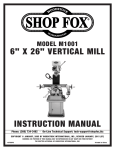
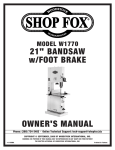
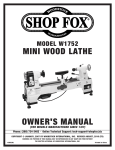
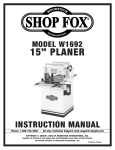
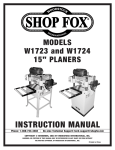
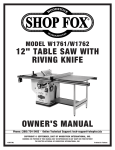
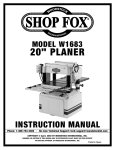
![平成25年9月発行(全文) [PDFファイル/1.41MB]](http://vs1.manualzilla.com/store/data/006623446_2-9a857bfc08b65df51095a2f4ed45f134-150x150.png)

